List of command flags of the Royal Navy
This is a list of historic and current command flags of the Royal Navy.
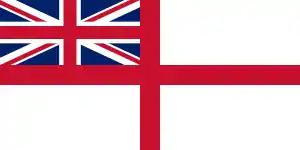 |
| Her Majesty's Naval Service of the British Armed Forces |
|---|
| Components |
|
|
| History and future |
|
| Ships |
| Personnel |
|
|
| Auxiliary services |
Command rank flags to denote the commander-in-chief of the English fleet and later Royal Navy were used from as early as 1189. Coloured squadrons of the Royal Navy were established during the Elizabethan era to subdivide the fleet into three squadrons or more. There were three classes of admirals and later a fourth that were differentiated by using coloured flags red, white and blue.[1]
History
.svg.png.webp) Arms of the Kingdom of England to 1198.
Arms of the Kingdom of England to 1198.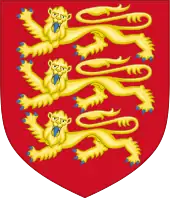 Arms of the Kingdom of England to 1199-1340.
Arms of the Kingdom of England to 1199-1340..svg.png.webp) Arms of the Kingdom of France.
Arms of the Kingdom of France.
The earliest known usage of a command flag being used to denote the Commander-in-Chief of the English Fleet was during the reign of Richard I in 1189 that depicted a single gold lion on a red background.[2] In 1198 it was changed to include three red lions against a red background which are still part of the royal coat arms of England till today.[2] In January 1340 Edward III proclaimed himself King of France and adopted the arms of France then displaying (multiple fleur-de-lis or azure semi-of-fleur-de-lis) in the upper left and the lower right cantons with the arms of England in the upper right and lower left cantons to create a new Royal Standard.[2] In 1411 Henry IV altered the French element of the standard to include just three fleur-de-lis.[2]
In June 1340 Edward III commanded the English fleet at the Battle of Sluys where the kings standard was flown at top of the main masthead this positioning of the only command flag used during that battle was later reserved for use by monarchs or his deputy commander the Lord Admiral.[2] In 1495 Henry VII authorized the use of his standard during the expeditions of John Cabot. In 1530 Henry VIII instructed Sir Thomas Audley to create a set of instructions that made clear which command flags are to be flown onboard ships and by whom at this time a single command flag was to be used at the top of the masthead. Audley produced the book of instructions called the Book of Orders for the War by Sea and Land.[3][4] Between 1545 and 1547 Lord Lisle under instructions from the King altered Audley's instructions this time to denote three squadron commanders as follows.[5]
The Lord Admiral shall fly the royal standard at the top of the main masthead and the flag of the cross of Saint George at the top of fore (front) masthead displaying two flags every ship in his squadron the captains were to fly a single Saint Georges flag at the top of the main masthead. The Admiral of the Van or (Vice-Admiral) of the front squadron flew two flags of Saint George one at the top of the main masthead center and the other at the top of the front masthead. All captains of ships in his squadron fly a single cross of Saint George at the top of the fore masthead. The Admiral of the Wyng or (Rear-Admiral) of the rear squadron to display two flags of Saint George one at the top of the main masthead center and the other at the top of the mizzenmast or rear mast head. All captains of ships in his squadron fly a single cross of Saint George at the top of the rear masthead.
From 1545, the Council of the Marine debated that it was necessary to identify which ship carried an admiral, and this achieved by flying the St. George Cross flag from the mizzen mast. When English fleets became larger flags started to become used as signals of a squadron to which a particular ship belonged to, this was initially done by flying a flag on either the foremast, or the mizzen mast or the top mast. The royal standards were used to identify which senior naval commander was on board. By 1588, only the royal arms, the national flags, and the squadron ensigns (by this time plain red, blue and white flags, for the first, second and third squadrons respectively) were used.[6]
The Navy Royal inaugurated squadron colours during the reign of Elizabeth I (1558-1603) to subdivide the English fleet into three squadrons. There were three classes of admirals and differentiated by using coloured flags.[7] In 1620 the official Flag ranks of Admiral, Vice Admiral, and Rear Admiral were legally established that arose directly out of the organisation of the fleet into three parts.[8]
Historic command flags
Royal Standard (1189-1627)
.png.webp) Command flag of Richard I as Commander in Chief English Fleet in 1189.
Command flag of Richard I as Commander in Chief English Fleet in 1189..png.webp) Command flag of monarchs of England as Commander in Chief English Fleet in 1199-1340.
Command flag of monarchs of England as Commander in Chief English Fleet in 1199-1340..svg.png.webp) Royal Standard of England 1340-1411 it also the command flag of the monarch or their deputy the lord admiral when on board ship at sea.
Royal Standard of England 1340-1411 it also the command flag of the monarch or their deputy the lord admiral when on board ship at sea..svg.png.webp) Royal Standard of England 1411-1553 and 1559-1603 it also the command flag of the monarch or their deputy the lord admiral when on board ship at sea..
Royal Standard of England 1411-1553 and 1559-1603 it also the command flag of the monarch or their deputy the lord admiral when on board ship at sea..
Admiralty flag (1588–1964)

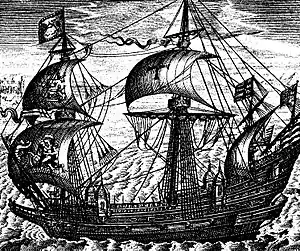
The Admiralty anchor flag first appears as a badge in the early 16th century that was mainly used for decorative purposes. The first time a specific flag was designed and flown was for the Lord Admiral of England Sir Lord Howard of Effingham on HMS Ark Royal as Commander-in-Chief of the English Fleet against the Spanish Armada in 1588. It would not be flown again until 1623 when the Lord Admiral the Duke of Buckingham was given an ensign depicting the admiralty anchor.[2] However it was rarely used for as a command flag for naval operations instead it became the main flag to signify the Admiralty and Marine Affairs Office.
Lord Admirals command flags (1545–1558)
Included:[2]
.svg.png.webp) First command Flag of the Lord Admiral of England under Henry VIII, Edward VI (1545-1553) when on board a ship.
First command Flag of the Lord Admiral of England under Henry VIII, Edward VI (1545-1553) when on board a ship.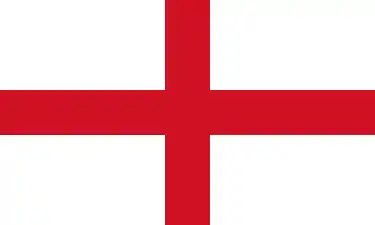 Second command Flag of the Lord Admiral of England (1547-1553) when on board a ship.
Second command Flag of the Lord Admiral of England (1547-1553) when on board a ship..jpg.webp) First command Flag of the Lord Admiral of England (1554-1558) under Mary I and Philip II when on board a ship.
First command Flag of the Lord Admiral of England (1554-1558) under Mary I and Philip II when on board a ship. Second command Flag of the Lord Admiral of England (1554-1558) when on board a ship.
Second command Flag of the Lord Admiral of England (1554-1558) when on board a ship.
Lord Admirals command flags (1559–1625)
Included:[2]
.svg.png.webp) First command Flag of the Lord Admiral of England under Elizabeth I (1559-1596) when on board a ship.
First command Flag of the Lord Admiral of England under Elizabeth I (1559-1596) when on board a ship. Second command Flag of the Lord Admiral of England (1545-1596) when on board a ship.
Second command Flag of the Lord Admiral of England (1545-1596) when on board a ship..svg.png.webp) First command Flag of the Lord Admiral of England (1603-1625) under James VI and I when on board a ship.
First command Flag of the Lord Admiral of England (1603-1625) under James VI and I when on board a ship. Second command Flag of the Lord Admiral of England (1545-1625) when on board a ship.
Second command Flag of the Lord Admiral of England (1545-1625) when on board a ship.
Vice and Rear Admirals of England command flags (1545–1596)

Included:[2]
 Vice Admiral of England command flag (1545-1596) when on board a ship.
Vice Admiral of England command flag (1545-1596) when on board a ship. Rear Admiral of England command flag (1545-1596) when on board a ship.
Rear Admiral of England command flag (1545-1596) when on board a ship.
- Note:The Vice Admiral flies two flags of Saint George flown at the top of the main center mast head the other at the top of the fore mast head.
- Note:The Rear Admiral flies two flags of Saint George flown at the top of the main center mast head the other at the top of the mizzen (rear) mast head.
Captains command flag in the Lord Admirals Squadron (1545–1596)
Included:[2]
 Captains command flag in the Lord Admirals squadron(1545-1596) when on board a ship.
Captains command flag in the Lord Admirals squadron(1545-1596) when on board a ship.
- Note: A captains ship in the Lord Admirals center squadron has the flag of Saint George flown at the top of the main center masthead.
- Note: A captains ship in the Van squadron (front) has the flag of Saint George flown at the top of the main fore masthead.
- Note: A captains ship in the Wyng squadron (rear) has the flag of Saint George flown at the top of the mizzen masthead.
Illustration of squadrons flagships and captains ships depicting position of command flags (1545-1596)
Included:[2] Lord Admirals squadron
.png.webp) Position of command flags on Lord Admirals flagship (1545-1596).
Position of command flags on Lord Admirals flagship (1545-1596)..png.webp) Position of captains flag on ship in Lord Admirals squadron (1545-1596)
Position of captains flag on ship in Lord Admirals squadron (1545-1596)
Vice Admirals squadron
.png.webp) Position of command flags on Vice Admirals flagship (1545-1596).
Position of command flags on Vice Admirals flagship (1545-1596)..png.webp) Position of captains flag on ship in Vice Admirals squadron (1545-1596)
Position of captains flag on ship in Vice Admirals squadron (1545-1596)
Rear Admirals squadron
.png.webp) Position of command flags on Rear Admirals flagship (1545-1596).
Position of command flags on Rear Admirals flagship (1545-1596)..png.webp) Position of captains flag on ship in Rear Admirals squadron (1545-1596)
Position of captains flag on ship in Rear Admirals squadron (1545-1596)
Squadron Admirals command flags (1558-1596)
- Command flags for other Vice or Rear Admirals that were not either an Admiral, Vice-Admiral or Rear-Admiral of the Fleet (England)
 Vice and Rear Admirals Red Squadron Kingdom of England
Vice and Rear Admirals Red Squadron Kingdom of England Vice and Rear Admirals White Squadron Kingdom of England
Vice and Rear Admirals White Squadron Kingdom of England Vice and Rear Admirals Blue Squadron Kingdom of England
Vice and Rear Admirals Blue Squadron Kingdom of England
Lord Admirals and General of the Army command flags (1596)
Included:[2]
Lord Admiral
.svg.png.webp) First command Flag of the Lord Admiral of England under Elizabeth I (1596) when on board a ship.
First command Flag of the Lord Admiral of England under Elizabeth I (1596) when on board a ship. Second command Flag of the Lord Admiral of England (1596) when on board a ship.
Second command Flag of the Lord Admiral of England (1596) when on board a ship.
General of the Army's command flag (1596)
Included:[2]
 Flag of the General of the Army's (1596) when on board a ship.
Flag of the General of the Army's (1596) when on board a ship.
In 1596 the expedition for Capture of Cádiz during the Anglo-Spanish War was led by joint commanders styled as "Generalls of the Armies by land and sea", Robert Devereux, 2nd Earl of Essex in command of land forces and Charles Howard, 1st Earl of Nottingham in command of naval forces, the English fleet consisted of four squadrons. Their immediate subordinates were Thomas Howard, 1st Earl of Suffolk as Vice Admiral of the Fleet and Sir Walter Raleigh as Rear Admiral of the Fleet. They both commanded a squadron and had a vice admiral (second-in-command) and rear admiral (third-in-command) subordinate to them. The command flags issued for that expedition are described as following.[9]
The Lord Admiral fly's the royal standard at the main masthead and the flag of the cross of Saint George at the fore (front). The Vice Admiral and Rear Admiral in the Lord Admirals squadron fly at the front and rear mastheads a red, white and blue seven stripped horizontal flag with the cross of saint George in the upper left canton. The Earl of Essex fly's only a single flag of the cross of saint George at the main, the Vice and Rear admiral in his squadron fly a saint George flag barred with blue stripes horizontal. The Vice Admiral of the Fleet to fly a green and white striped flag with the cross of saint George in the upper left canton main mast head and flag of saint George front mast head. The Vice and Rear admirals in his squadron flew the same flags in their respective positions (proper masthead). The Rear Admiral of the Fleet to fly a green and white striped flag with the cross of saint George in the upper left canton main mast head and flag of saint George rear mast head. The Vice and Rear admirals in his squadron flew plain white flags in their respective positions (main and front) and (main and Rear) mastheads.
Note: Originally discussions that took place before fleet was sent to Cadiz considered four colours to identify each squadron they were a plain flag tawny orange (orange squadron), a plain crimson flag (red) (crimson squadron), a plain blue flag (blue squadron) and a plain white flag (white squadron).[10]
Vice and Rear Admirals command flags in the Lord Admirals squadron (1596)
Included:[2]
.jpg.webp) Vice Admirals and Rear Admirals of the Lord Admirals squadron first command flag (1596) are flown in their respective positions on the masthead.
Vice Admirals and Rear Admirals of the Lord Admirals squadron first command flag (1596) are flown in their respective positions on the masthead. Vice Admirals and Rear Admirals of the Lord Admirals squadron second command flag (1596) are flown in their respective positions on the masthead.
Vice Admirals and Rear Admirals of the Lord Admirals squadron second command flag (1596) are flown in their respective positions on the masthead.
Vice and Rear Admirals command flags in the General of the Army's (1596)
Included:[2]
.jpg.webp) Vice and Rear Admirals command flags in the General of the Army's squadron to Cadiz (1596) are flown in their respective positions.
Vice and Rear Admirals command flags in the General of the Army's squadron to Cadiz (1596) are flown in their respective positions.
Vice Admiral and Rear Admirals of the Fleet command flags (1596)
Included:[2]
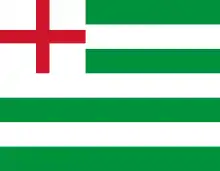 Vice Admirals and Rear Admirals of the Fleet first command flag (1596) that is flown in its respective position on the relevant masthead.
Vice Admirals and Rear Admirals of the Fleet first command flag (1596) that is flown in its respective position on the relevant masthead. Vice Admirals and Rear Admirals of the Fleet second command flag (1596) that is flown in its respective position on the relevant masthead.
Vice Admirals and Rear Admirals of the Fleet second command flag (1596) that is flown in its respective position on the relevant masthead.
Vice and Rear Admirals command flags in the Rear Admirals of the fleet squadrons (1596)
Included:[2]
 Vice Admirals in the Rear Admirals of Fleet squadron fly two plain white flags in their respective positions (1596).
Vice Admirals in the Rear Admirals of Fleet squadron fly two plain white flags in their respective positions (1596). Rear Admirals in the Rear Admirals of the Fleet squadron fly two plain white flags in their respective positions (1596).
Rear Admirals in the Rear Admirals of the Fleet squadron fly two plain white flags in their respective positions (1596).
Illustration of squadrons flagships depicting position of command flags (1596)
Included:[2] Lord Admirals squadron
.png.webp) Position of command flags on Lord Admirals flagship (1596).
Position of command flags on Lord Admirals flagship (1596)..png.webp) Position of command flags of Vice Admirals flagship of Lord Admirals Squadron English Navy (1596)
Position of command flags of Vice Admirals flagship of Lord Admirals Squadron English Navy (1596).png.webp) Position of command flags of Rear Admirals flagship of Lord Admirals Squadron English Navy (1596)
Position of command flags of Rear Admirals flagship of Lord Admirals Squadron English Navy (1596)
General of the Army's squadron
.png.webp) Position of command flags on General of the Army's flagship (1596).
Position of command flags on General of the Army's flagship (1596)..png.webp) Position of command flag of Vice Admirals flagship of General of the Army's squadron English Navy (1596)
Position of command flag of Vice Admirals flagship of General of the Army's squadron English Navy (1596).png.webp) Position of command flag of Rear Admirals flagship of General of the Army's English Navy (1596)
Position of command flag of Rear Admirals flagship of General of the Army's English Navy (1596)
Vice Admirals of the Fleet squadron
.png.webp) Vice Admirals of the Fleet flagship English Navy (1596) and position of his command flags.
Vice Admirals of the Fleet flagship English Navy (1596) and position of his command flags..png.webp) Vice Admirals flagship in the Vice Admirals of the Fleet Squadron English Navy (1596) and position of his command flags.
Vice Admirals flagship in the Vice Admirals of the Fleet Squadron English Navy (1596) and position of his command flags.
Rear Admirals of the Fleet squadron
.png.webp) Rear Admirals of the Fleet flagship English Navy (1596) and position of his command flags.
Rear Admirals of the Fleet flagship English Navy (1596) and position of his command flags..png.webp) Rear Admirals Flagship in the Rear Admirals of the Fleet Squadron English Navy (1596) and position of his command flags.
Rear Admirals Flagship in the Rear Admirals of the Fleet Squadron English Navy (1596) and position of his command flags.
Admirals command flags expedition to Cadiz (1625)
Included:[2]
 The Admirals flag commanding red squadron for the expedition to Cadiz in (1625).
The Admirals flag commanding red squadron for the expedition to Cadiz in (1625). The Admirals command flag commanding white squadron for the expedition to Cadiz in (1625).
The Admirals command flag commanding white squadron for the expedition to Cadiz in (1625). The Admirals command flag commanding blue squadron for the expedition to Cadiz in (1625).
The Admirals command flag commanding blue squadron for the expedition to Cadiz in (1625).
In 1625 there was a second Cádiz expedition in which the English fleet was divided into three coloured squadrons each commanded by an admiral of the red, white and blue. Perrin (1922) does note indicate what flag rank these officers were suffice to say there was no admiral of the red in existence until 1805 so we must assume they were vice-admirals.
Admirals command flags expedition to attack Cadiz October (1625)
Included:[2]
Admiral of the Fleet and Commander-in-Chief's squadron
.svg.png.webp) Admiral and C-in-C attack on Cadiz in October/November (1625) was instructed to fly this command flag at the main mast though he was not Lord Admiral.
Admiral and C-in-C attack on Cadiz in October/November (1625) was instructed to fly this command flag at the main mast though he was not Lord Admiral..png.webp) Vice Admirals command flag in the commander in chief's squadron for the expedition to Cadiz in (1625) flown at the top of the main mast.
Vice Admirals command flag in the commander in chief's squadron for the expedition to Cadiz in (1625) flown at the top of the main mast..png.webp) Rear Admirals command flag in the commander in chief's squadron for the expedition to Cadiz in (1625) flown at the top of the main mast.
Rear Admirals command flag in the commander in chief's squadron for the expedition to Cadiz in (1625) flown at the top of the main mast.
Vice Admiral of the Fleets squadron
 Plain blue command flag at the main mast.
Plain blue command flag at the main mast. Vice and Rear Admirals in this squadron fly the same flag but at the fore and mizzen masts positions.
Vice and Rear Admirals in this squadron fly the same flag but at the fore and mizzen masts positions.
Rear Admiral of the Fleets squadron
 Plain white command flag at the main mast.
Plain white command flag at the main mast. Vice and Rear Admirals in this squadron fly the same flag but at the fore and mizzen masts positions.
Vice and Rear Admirals in this squadron fly the same flag but at the fore and mizzen masts positions.
Admirals command flags at the Siege of Saint-Martin-de-Ré in (1627)
Included:[2]
- Admiral of the Fleet and Commander-in-Chief's squadron
.svg.png.webp) Admiral and C-in-C attack on Cadiz in October/November (1625) was instructed to fly the royal standard as his command flag at the main mast though he was not Lord Admiral.
Admiral and C-in-C attack on Cadiz in October/November (1625) was instructed to fly the royal standard as his command flag at the main mast though he was not Lord Admiral.
Vice Admiral of the Fleets squadron
.svg.png.webp) Vice Admiral of the Fleet to fly union flag at the fore mast.
Vice Admiral of the Fleet to fly union flag at the fore mast. He also flew a plain blue command flag at the main mast.
He also flew a plain blue command flag at the main mast.
Rear Admiral of the Fleets squadron
.svg.png.webp) Vice Admiral of the Fleet to fly union flag at the mizzen or rear mast.
Vice Admiral of the Fleet to fly union flag at the mizzen or rear mast. He also flew a plain white command flag at the main mast.
He also flew a plain white command flag at the main mast.
- Additional squadrons in this expedition
Lord Denbigh's squadron
 Flew the flag of England at the main mast.
Flew the flag of England at the main mast.
Sir John Pennington's squadron
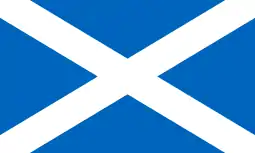 Flew the flag of Scotland at the main mast.
Flew the flag of Scotland at the main mast.
Of note: A fleet of 100 ships was assembled for the Siege of Saint-Martin-de-Ré, France in 1627, this was the only time an English admiral flew the Scottish saltaire as his command flag.
Standardisation of command flags after (1627 to 1649)
From 1628 following the creation of the Board of Admiralty and the post of Lord Admiral placed in abeyance the Royal Standard was not used thereafter as the command flag at sea for a Commander-in-Chief of the English Navy. The Lord High Admirals office was revived only two more times after this date in 1702 and in 1828 with the office holders functioning in an administrative capacity.
Flag officers small fleets
.svg.png.webp) The senior admiral to fly the union flag main mast unless he was Lord Admiral in which case the royal standard is flown. The second in command vice admiral to fly a union flag at the fore mast and third in command rear admiral a union flag flown at the mizzen mast.
The senior admiral to fly the union flag main mast unless he was Lord Admiral in which case the royal standard is flown. The second in command vice admiral to fly a union flag at the fore mast and third in command rear admiral a union flag flown at the mizzen mast.
Note: Small fleets that consisted of three squadrons the admirals commanding were instructed to fly the above command flags in their correct positions.
Flag officers large fleets
Included:[2]
 Admiral of the White Squadron command flag 1625 to 1649.
Admiral of the White Squadron command flag 1625 to 1649. Admiral of the Blue Squadron command flag 1625 to 1649.
Admiral of the Blue Squadron command flag 1625 to 1649. Vice Admiral of the Red Squadron command flag 1625 to 1649.
Vice Admiral of the Red Squadron command flag 1625 to 1649.
Order of precedence The squadrons ranked in order red, white, and blue, with admirals ranked according to their squadron with their command flags flown in their respective positions
- Admiral of the Fleet
- Admiral of the white
- Admiral of the blue
- Vice-Admiral of the red (no rank of admiral of the red until 1805)
- Vice admiral of the white
- Vice admiral of the blue
- Rear-admiral of the red
- Rear-Admiral of the White
- Rear-Admiral of the Blue
- Commodore of the red
- Commodore of the white
- Commodore of the blue
Changes in command flags commonwealth of England from (1649 to 1660)
Following the execution of Charles I of England, the royal standard was replaced by the Commonwealth standard, with the cross and harp this was used as the main command flag for the General's at Sea together with a designated squadron ensign.[2]
- Included:[2]
Generals at Sea in command of the red squadron
.svg.png.webp) Flag of the commonwealth flown at the main mast.
Flag of the commonwealth flown at the main mast..png.webp) Red ensign flown at the aft mast.
Red ensign flown at the aft mast. Flag dating to 1652–54, currently held by the Royal Museums Greenwich.[11]
Flag dating to 1652–54, currently held by the Royal Museums Greenwich.[11]
Generals at Sea in command of the white squadron
.svg.png.webp) Flag of the commonwealth flown at the main mast.
Flag of the commonwealth flown at the main mast. White ensign flown at the aft mast.
White ensign flown at the aft mast.
Generals at Sea in command of the blue squadron
.svg.png.webp) Flag of the commonwealth flown at the main mast.
Flag of the commonwealth flown at the main mast. Blue ensign flown at the aft mast.
Blue ensign flown at the aft mast.
Vice Admiral of the Fleets squadron
 Plain red flag flown at the main mast.
Plain red flag flown at the main mast..png.webp) Red ensign flown at the aft mast.
Red ensign flown at the aft mast.
Vice Admiral of the Grand squadron
 Plain white flag flown at the main mast.
Plain white flag flown at the main mast. White ensign flown at the aft mast.
White ensign flown at the aft mast.
Rear Admiral of the Fleet (Blue) acting as Vice Admiral of the Grand squadron
 Plain white flag flown at the main mast.
Plain white flag flown at the main mast. Plain blue flag flown at the fore mast.
Plain blue flag flown at the fore mast. Blue ensign flown at the aft mast.
Blue ensign flown at the aft mast.
Note: During this period the rest of the commonwealth fleet was divided into nine formations each assigned red, white and blue colours that included plain flags and the coloured ensigns. At the Restoration
Previous command flags re-established (1660 to 1702)
In 1660 the all previous command flags used during the commonwealth period were changed back to what they were from 1627 to 1649. However during this period we see the introduction of the post of Commodore being initially recognized (though not formally) in November 1674. The Board of Admiralty on the advice of the Navy Board approved the use of the first pendant (later known as a pennant) to denote the command flag of senior officer in charge of a small squadron under a captain as a plain red pendant. The use of the flag became known as The Distinction Pendant to denote a Commander-in-Chief who did not hold flag rank. In January 1684 a proposal was put forward to distinguish two senior officers in a small squadron based on their age difference and relevant naval experience it recommended the issuing of two pendants a plain red of distinction with a white cross for the officer of distinction and a smaller plain red for the officer of the ordinary this separating of two types of commodores would evolve into those of the first class and second class. In 1734 the title of commodore was formally approved by an Order in Council. In 1806 the temporary flag rank of Commodore was to be distinguished by a 'Broad Plain Pennant' of either red, white or blue. The ordinary commodore commanding a ship themselves would have the same coloured pennants but with a single large white ball near the staff.[2] Below for illustrative purpose is what they might have looked like.
Note: Perrin (1922) in his descriptions of admirals command flags does not mention the commodore ordinary of the white squadrons pendant in relation to the 1805 changes thus we must assume that as the Red and Blue squadrons officers were changed to large white balls; the white squadron had to have a large red ball.
.jpg.webp) Commodore distinction red squadron 1674 .
Commodore distinction red squadron 1674 ..svg.png.webp) Commodore distinction white squadron 1674
Commodore distinction white squadron 1674.png.webp) Commodore distinction pendant 1684.
Commodore distinction pendant 1684..png.webp) Commodore ordinary pendant 1684.
Commodore ordinary pendant 1684.
.png.webp) Commodore ordinary red squadron 1805.
Commodore ordinary red squadron 1805. Commodore ordinary white squadron 1805.
Commodore ordinary white squadron 1805..jpg.webp) Commodore ordinary blue squadron 1805.
Commodore ordinary blue squadron 1805.
Changes in command flags in February (1702)
Included:[2]
- In February 1702 the Senior Naval Lord Sir George Rooke sent instructions to the Navy Board requesting a new structure for command flags to be flown.
Lord High Admiral
.svg.png.webp) Lord Admiral the Royal standard flown at the main mast.
Lord Admiral the Royal standard flown at the main mast..png.webp) Red ensign flown at the aft mast.
Red ensign flown at the aft mast.
Vice and Rear Admirals in red squadron
 Vice and Rear Admirals of the Lord Admirals squadron fly plain red flags at the main mast .
Vice and Rear Admirals of the Lord Admirals squadron fly plain red flags at the main mast ..png.webp) Red ensign flown at the aft mast.
Red ensign flown at the aft mast.
Admiral of the White
.svg.png.webp) Flag of the union at the main mast.
Flag of the union at the main mast. White ensign flown at the aft mast.
White ensign flown at the aft mast.
Vice and Rear Admirals in white squadron
.svg.png.webp) Vice Admiral fly's union flag at the fore mast and Rear Admiral of the squadron fly's the union flag at the mizzen mast.
Vice Admiral fly's union flag at the fore mast and Rear Admiral of the squadron fly's the union flag at the mizzen mast. Both flag officers the white ensign flown at the aft mast.
Both flag officers the white ensign flown at the aft mast.
Admiral of the Blue
 Plain blue flag flown at the fore mast
Plain blue flag flown at the fore mast Blue ensign flown at the aft mast.
Blue ensign flown at the aft mast.
Changes in command flags from March (1702 to 1864)
On 24 March 1702 the First Lord of the Admiralty instructed the Senior Naval Lord Admiral Sir George Rooke and Board of Admiralty to have designed new command flags for flag officers. These would remain in place with some minor changes until 1805 when the rank of Admiral of the Red is introduced and included the following:[12][13]
Admiral of the Fleet
- Flag of the union flown at main topgallant masthead as his proper flag. The Union flag was used as a maritime flag in 1606 during the reign of James VI and I (of Scotland 1567-1625, of England and Ireland 1603-1625), though the actual union of the kingdoms of England and Scotland did not occur until 1707 and that with Ireland until 1801.
.svg.png.webp) Admiral of the Fleet to fly the Union Flag of the Union later Great Britain (1606–1801) as his proper flag.
Admiral of the Fleet to fly the Union Flag of the Union later Great Britain (1606–1801) as his proper flag. Admiral of the Fleet to fly the Union Flag of the United Kingdom (1801–current) as his proper flag.
Admiral of the Fleet to fly the Union Flag of the United Kingdom (1801–current) as his proper flag.
Admirals
- Flags flown at main topgallant masthead as his proper flag.
 Admiral of the Red Squadron command flag 1805 to 1864 for use in the Kingdom of Great Britain and United Kingdom.
Admiral of the Red Squadron command flag 1805 to 1864 for use in the Kingdom of Great Britain and United Kingdom. Admiral of the White Squadron command flag 1625 to 1702 for use in the Kingdom of England and Great Britain.
Admiral of the White Squadron command flag 1625 to 1702 for use in the Kingdom of England and Great Britain.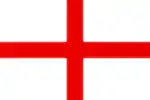 Admiral of the White Squadron command flag 1702 to 1864 for use in the Kingdom of England, Great Britain and the United Kingdom.
Admiral of the White Squadron command flag 1702 to 1864 for use in the Kingdom of England, Great Britain and the United Kingdom. Admiral of the Blue Squadron command flag 1625 to 1864 for use in the Kingdom of England, Great Britain and the United Kingdom.
Admiral of the Blue Squadron command flag 1625 to 1864 for use in the Kingdom of England, Great Britain and the United Kingdom.
Vice Admirals
- Flags flown at the fore topgallant masthead as his proper flag.
 Vice Admiral of the Red Squadron command flag 1702 to 1805 for use in the Kingdom of Great Britain.
Vice Admiral of the Red Squadron command flag 1702 to 1805 for use in the Kingdom of Great Britain. Vice Admiral of the Red Squadron command flag 1805 to 1864 for use in the Kingdom of Great Britain and the United Kingdom.
Vice Admiral of the Red Squadron command flag 1805 to 1864 for use in the Kingdom of Great Britain and the United Kingdom. Vice Admiral of the White Squadron command flag 1702 to 1805 for use in the Kingdom of Great Britain.
Vice Admiral of the White Squadron command flag 1702 to 1805 for use in the Kingdom of Great Britain.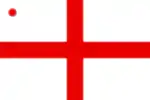 Vice Admiral of the White Squadron command flag 1805 to 1864 for use in the Kingdom of Great Britain and the United Kingdom.
Vice Admiral of the White Squadron command flag 1805 to 1864 for use in the Kingdom of Great Britain and the United Kingdom. Vice Admiral of the Blue Squadron command flag 1702 to 1864 for use in the Kingdom of Great Britain and the United Kingdom.
Vice Admiral of the Blue Squadron command flag 1702 to 1864 for use in the Kingdom of Great Britain and the United Kingdom.
Rear Admirals
- Flags flown at the mizzen topgallant masthead as his proper flag.
 Rear Admiral of the Red Squadron command flag 1702 to 1864 for use in the Kingdom of Great Britain and the United Kingdom.
Rear Admiral of the Red Squadron command flag 1702 to 1864 for use in the Kingdom of Great Britain and the United Kingdom. Rear Admiral of the White Squadron command flag 1702 to 1805 for use in the Kingdom of Great Britain and the United Kingdom.
Rear Admiral of the White Squadron command flag 1702 to 1805 for use in the Kingdom of Great Britain and the United Kingdom.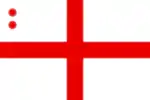 Rear Admiral of the White Squadron command flag 1805 to 1864 for use in the Kingdom of Great Britain and the United Kingdom.
Rear Admiral of the White Squadron command flag 1805 to 1864 for use in the Kingdom of Great Britain and the United Kingdom. Rear Admiral of the Blue Squadron command flag 1702 to 1864 for use in the Kingdom of Great Britain and the United Kingdom.
Rear Admiral of the Blue Squadron command flag 1702 to 1864 for use in the Kingdom of Great Britain and the United Kingdom.
Commodores
- Broad pennants flown at the mizzen topgallant masthead as his proper flag.
 Commodore first class Red Squadron command flag 1826 to 1864 for use in the Kingdom of Great Britain and United Kingdom.
Commodore first class Red Squadron command flag 1826 to 1864 for use in the Kingdom of Great Britain and United Kingdom..svg.png.webp) Commodore first class White Squadron command flag 1826 to 1864 for use in the Kingdom of Great Britain and United Kingdom.
Commodore first class White Squadron command flag 1826 to 1864 for use in the Kingdom of Great Britain and United Kingdom. Commodore second class all squadrons a plain blue command flag 1826 to 1864 for use in the Kingdom of Great Britain and the United Kingdom.
Commodore second class all squadrons a plain blue command flag 1826 to 1864 for use in the Kingdom of Great Britain and the United Kingdom.
- Order of precedence from 1805
The squadrons ranked in order red, white, and blue, with admirals ranked according to their squadron with their command flags flown in their respective positions:
Changes in command flags and standardized from (1864-current)
Admirals of the Fleet
 Admiral of the Fleet, Royal Navy command flag for use in the United Kingdom from 1864.
Admiral of the Fleet, Royal Navy command flag for use in the United Kingdom from 1864.
Admirals
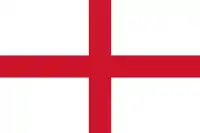 Admiral of the Royal Navy command flag for use in the United Kingdom from 1864
Admiral of the Royal Navy command flag for use in the United Kingdom from 1864
Vice Admirals
 Vice Admiral of the Royal Navy command flag for use in the United Kingdom from 1864
Vice Admiral of the Royal Navy command flag for use in the United Kingdom from 1864
Rear Admirals
 Rear Admiral of the Royal Navy command flag for use in the United Kingdom from 1864
Rear Admiral of the Royal Navy command flag for use in the United Kingdom from 1864
Commodores
.svg.png.webp) Commodore first class of the Royal Navy command flag for use in the United Kingdom from 1864-1954
Commodore first class of the Royal Navy command flag for use in the United Kingdom from 1864-1954 Commodore second class of the Royal Navy command flag for use in the United Kingdom from 1864-1954
Commodore second class of the Royal Navy command flag for use in the United Kingdom from 1864-1954 Commodore of the Royal Navy command flag for use in the United Kingdom from 1954
Commodore of the Royal Navy command flag for use in the United Kingdom from 1954
Current standards and definitions for flying command flags (2015)
The following official instructions issued by the Ministry of Defence, 1 April 2015.[17]
- The Royal Standard
- The Royal Standard, being the personal flag of the Sovereign, is to be hoisted on board HM ships and on official buildings and enclosures only when the Sovereign is present.[18]
- Lord High Admiral
- The Flag of the Lord High Admiral. The flag of the Lord High Admiral is to be hoisted, on occasions when the Lord High Admiral, His Royal Highness, The Duke of Edinburgh, is present with any body of Royal Naval or Royal Marines forces, afloat or ashore, and on such other maritime occasions as The Lord High Admiral may command.[19]
Flag Officers
- Admirals: Flags. Admirals of the Fleet, former First Sea Lords and Admirals who are or have been Chief of Defence Staff are to fly the Union Flag at the main when embarked in one of HM Ships or visiting one of HM establishments. The incumbent First Sea Lord is to fly the flag of an Admiral. The flag of an Admiral is to be flown at the main whilst other Flag Officers are to fly their flags at the fore. The flag of an Admiral is to take precedence over the flags of Admirals who are former First Sea Lords and former Admirals who have been Chief of Defence Staff when embarked at the same time unless otherwise directed.[20]
Commodores
- Commodores’ Broad Pennants: Commodores are to fly their broad pennant at the fore. Commodores RNR on the Active List are to fly their broad pennant in the ship or establishment to which they are affiliated.[21]
Standard squadron colours
Coloured squadrons were established as early as the 1580s. In 1864, after approximately 368 years, the designation of coloured squadrons and the promotion path of flag officers under this system were abolished.
Descriptions of flags of admirals of the colour
Included:[22]
- Lord Admiral and Lord High Admiral of England (royal standard, on three occasions the admiralty anchor flag to 1702)
- Admiral of the Fleet (flag of England or union flag or royal standard if instructed to fly it or flag of the commonwealth of England to 1864)
- Admiral of the Red (plain red flag 1805 to 1864)
- Admiral of the White (plain white flag 1625 to 1705)
- Admiral of the White (St George flag 1702 to 1864)
- Admiral of the Blue (plain blue flag 1625 to 1864)
- Vice-Admiral of the Red (plain red flag 1702 to 1805)
- Vice-Admiral of the Red (plain red flag with one white ball in the upper left canton from 1805 to 1864)
- Vice-Admiral of the White (St George cross with one blue ball in the upper left canton from 1702 to 1805)
- Vice-Admiral of the White (St George cross with one red ball in the upper left canton from 1805 to 1864)
- Rear-Admiral of the Blue (plain blue flag with one white ball in the upper left canton from 1702 to 1864)
- Rear-Admiral of the Red (plain red flag with two white balls in the upper left canton from 1702 to 1864)
- Rear-Admiral of the White (St George cross with two blue balls in the upper left canton from 1702 to 1805)
- Rear-Admiral of the White (St George cross with two white balls in the upper left canton from 1805 to 1864)
- Rear-Admiral of the Blue (plain blue flag with two white balls in the upper left canton from 1702 to 1864)
- Commodore of the Red first class (plain red broad pennant from 1826 to 1864)
- Commodore of the White first class (cross of St George on a white broad pennant 1826 to 1864)
- Commodore of the White second class (cross of St George with a red ball in the upper left canton on a white broad pennant 1864 to 1954)
- Commodore of the Blue second class all squadrons (plain blue broad pennant from 1826 to 1864)
Note:First and second class commodore ranks were introduced in 1826 the first class commodore commanded captains and ships the second class commodore flew a different broad pennant when on board a ship and in command himself.[23]
Rank flags from 1864
- Admiral of the Fleet (union flag from 1864–present)
- Admiral (cross of st George from 1864–present)
- Vice-Admiral (cross of st George with a larger single red ball upper left canton)
- Rear-Admiral (of cross of st George with two larger red balls upper left canton)
- Commodore (cross of st George on a white broad pennant 1954–present)
- Commodore first class (cross of St George on a white broad pennant 1864-1954)
- Commodore second class (cross of St George with a red ball in the upper left canton on a white broad pennant 1864 to 1954)
Notes
- The origins of the earlier flag of Great Britain date back to 1606. James VI of Scotland had inherited the English and Irish thrones in 1603 as James I, thereby uniting the crowns of England, Scotland, and Ireland in a personal union, although the three kingdoms remained separate states. On 12 April 1606, a new flag to represent this regal union between England and Scotland was specified in a royal decree, according to which the flag of England (a red cross on a white background, known as St George's Cross), and the flag of Scotland (a white saltire on a blue background, known as the Saltire or St Andrew's Cross), would be joined together, forming the flag of England and Scotland for maritime purposes. King James also began to refer to a "Kingdom of Great Britaine", although the union remained a personal one.
- The rank of commodore was introduced during the 17th century though not legally established until 1806. They were formally separated into first class (those with subordinate line captains) and second class (those commanding ships themselves) in 1826. The previous broad red and blue pennants were abolished in 1864 along with the coloured squadrons, the commodore of the white's broad pennant with the cross of saint George remained as the command flag for a first class commodore. The white broad pennant with a red ball was introduced as the command flag for the second class commodore. These two flags existed until 1958 when the broad pennant without a ball was abolished leaving the pennant with a single red ball to cover all Royal Navy commodores.
References
Citations
- "Information sheet no 55 Squadron Colours" (PDF). National Museum of the Royal Navy. 2014. Retrieved 8 October 2018.
- Perrin, W. G. (William Gordon) (1922). "Flags of Command". British flags, their early history, and their development at sea; with an account of the origin of the flag as a national device. Cambridge, England: Cambridge : The University Press. p. 77.
- Childs, David (2014). "Captain and Commanders". The Warship Mary Rose: The Life and Times of King Henry VII's Flagship. Barnsley, England: Seaforth Publishing. p. 67. ISBN 9781473853096.
- "College History, Tudor Times". Madgalene College website. Archived from the original on 27 March 2009. Retrieved 7 October 2018.
- Perrin, W. G. (William Gordon) (1922). "Flags of Command:Admirals Flags". British flags, their early history, and their development at sea; with an account of the origin of the flag as a national device. Cambridge, England: Cambridge : The University Press. p. 87.
- Loades, David M. (1996). The Tudor Navy : an administrative, political, and military history. Farnham, England: Scolar Press. p. 74. ISBN 9780859679220.
- "Information sheet no 055: Squadron Colours" (PDF). nmrn-portsmouth.org.uk. The National Museum Royal Navy. 2014. Retrieved 13 February 2019.
- "Naval Ranks NMRN Portsmouth". www.nmrn-portsmouth.org.uk. Portsmouth, England: The National Museum of the Royal Navy. 2015. Retrieved 13 February 2019.
- Perrin, W. G. (William Gordon) (1922). "Flags of Command:Admirals Flags". British flags, their early history, and their development at sea; with an account of the origin of the flag as a national device. Cambridge, England: Cambridge : The University Press. p. 88.
- Oppenheim, Michael (1896). "Elizabeth (1558-1603)". A history of the administration of the royal navy and of merchant shipping in relation to the navy, from MDIX to MDCLX, with an introduction treating of the preceding period. London, England and New York, USA: London, New York, J. Lane. pp. 115–184.
- https://collections.rmg.co.uk/collections/objects/800.html
- Admiralty, Great Britain (1757). "III". Regulations and Instructions Relating to His Majesty's Service at Sea (IX ed.). London, England. p. 12.
- Admiralty, Great Britain (1862). "XI: Distinguishing Flags". The Queen's Regulations for the Royal Navy: Revised ... London, England: H.M.Stationery office. pp. 17–19.
- "Broad pennant". collections.rmg.co.uk. London, England: Royal Museums Greenwich, National Maritime Museum. 1857. Retrieved 9 October 2018.
- Grieve, Martin; Raeside, Rob; Southworthy, Christopher (26 December 2003). "United Kingdom: Royal Navy rank flags". International Federation of Vexillological Associations.
- Grieve, Martin; Raeside, Rob; Southworth, Christopher. "United Kingdom: Royal Navy rank flags". Retrieved 9 October 2018.
- "Queens Regulations for the Royal Navy: Chapter 91" (PDF). royalnavy.mod.uk. London, England: Ministry of Defence, United Kingdom. 1 April 2015. pp. 9101–9106.
- "Queens Regulations for the Royal Navy: Chapter 91" (PDF). royalnavy.mod.uk. London, England: Ministry of Defence, United Kingdom. 1 April 2015. pp. 9101–9106.
- "Queens Regulations for the Royal Navy: Chapter 91" (PDF). royalnavy.mod.uk. London, England: Ministry of Defence, United Kingdom. 1 April 2015. pp. 9101–9106.
- "Queens Regulations for the Royal Navy: Chapter 91" (PDF). royalnavy.mod.uk. London, England: Ministry of Defence, United Kingdom. 1 April 2015. pp. 9101–9106.
- "Queens Regulations for the Royal Navy: Chapter 91" (PDF). royalnavy.mod.uk. London, England: Ministry of Defence, United Kingdom. 1 April 2015. pp. 9101–9106.
- Perrin, W. G. (William Gordon) (1922). "IV:Flags of Command". British flags, their early history, and their development at sea; with an account of the origin of the flag as a national device. Cambridge, England: Cambridge : The University Press. pp. 73–109.
- Grieve, Martin; Raeside, Rob; Southworthy, Christopher (26 December 2003). "United Kingdom: Royal Navy rank flags". International Federation of Vexillological Associations.
Sources
- Admiralty, Great Britain (1757). "III". Regulations and Instructions Relating to His Majesty's Service at Sea (IX ed.). London, England. .
- Admiralty, Great Britain (1862). "XI: Distinguishing Flags". The Queen's Regulations for the Royal Navy: Revised ... London, England: H.M.Stationery office.
- Childs, David (2014). "Captain and Commanders". The Warship Mary Rose: The Life and Times of King Henry VII's Flagship. Barnsley, England: Seaforth Publishing. ISBN 9781473853096.
- Defence, Ministry of (2015) "Queens Regulations for the Royal Navy: Chapter 91" (PDF). royalnavy.mod.uk. London, England: Ministry of Defence, United Kingdom.
- Grieve, Martin; Raeside, Rob; Southworthy, Christopher (2003). "United Kingdom: Royal Navy rank flags". International Federation of Vexillological Associations.
- Oppenheim, Michael (1896). "Elizabeth (1558-1603)". A history of the administration of the royal navy and of merchant shipping in relation to the navy, from MDIX to MDCLX, with an introduction treating of the preceding period. London, England and New York, USA: London, New York, J. Lane.
- Perrin, W. G. (William Gordon) (1922). "Flags of Command: Admirals Flags". British flags, their early history, and their development at sea; with an account of the origin of the flag as a national device. Cambridge, England: Cambridge University Press.
- Squadron Colours" (2014), (PDF). National Museum of the Royal Navy.
- Attribution
- This article contains a supporting note compiled from copied content in relation to this article Union Jack.